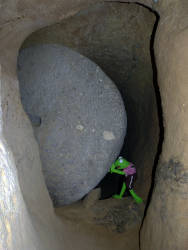Underground Cities


An Underground City is probably exactly what you think first: it is a series of underground structures which form a city.
While a single place for living is a
 Cave House
an underground city requires much more:
Cave House
an underground city requires much more:
- a decent size, or in other words lots of space
- infrastructure like workshops, storage rooms, kitchens, meeting rooms
- a connection of all rooms through some sort of passage (streets, staircases)
- infrastructure for basic needs (water, sewage, light, air)
This is - by the way - not a real definition. This term is not a scientific term, it’s just a descriptive term used for classification. In other words, this page is describing how this term is used on showcaves.com and nothing more. Nevertheless, if you look at the respective Wikipedia page, you will see that the definition there is quite identical. There are discussions on how to exactly define the term. We include the following three types of underground structures.
Archaeological or Historic Underground Cities
During history, man built underground cities for reasons like defensive refuge or protection from climatic influences. Or simply because hollowing out soft rock is sometimes easier than erecting a building.
Nice examples for this are the underground cities in Cappadolia, where early Christians lived underground because they were persecuted for their religion by non-Christian neighbours. Or underground cities on the Krim peninsula, which were built underground to hide from the frequent raids of the neighbours. Or they used underground structures which already existed, normally because of mining activities.
 Çukurören Yeraltı Şehri
Çukurören Yeraltı Şehri Derinkuyu Yeraltı Şehri
Derinkuyu Yeraltı Şehri Kaymaklı Yeraltı Şehri
Kaymaklı Yeraltı Şehri Mazı Yeraltı Şehri
Mazı Yeraltı Şehri Underground City of Nushabad
Underground City of Nushabad Özkonak Yeralti Şehri
Özkonak Yeralti Şehri Özlüce Yeraltı Şehri
Özlüce Yeraltı Şehri Saratlı Kırkgöz Yeraltı Şehri
Saratlı Kırkgöz Yeraltı Şehri Aziz Mercurius Yeraltı Şehri ve Kilisesi
Aziz Mercurius Yeraltı Şehri ve Kilisesi Tatlarin Yeraltı Şehri
Tatlarin Yeraltı Şehri Zağ Mağarası
Zağ Mağarası
Modern Underground Cities


Even today, there are good reasons to build underground. Normally it’s not persecution or frequent raids, as we handle that with open or not so open wars. Mostly, it’s a result of an extreme lack of space in modern cities or to avoid the nasty climate. An american synonym for such a city would be underground mall.
Fine examples for the climate thing are the underground cities in Canada, most famous is probably PATH in Toronto or the Ville Souterraine in Montreal. Others are found in Finland, Russia, and other northern countries where the temperature, ice, and snow in winter are an issue. The same with high temperatures can be found in Australia, Spain, and Iran.
And of course there is the main reason for anything: money! A lot of those cities developed because many people used the subway to get into the city, someone opened a shop which was frequented by commuters and flourished. The results are underground shopping malls of enormous size, which may even connect two or more subway stations. So if you are done with shopping, you just look for the next station to get home...
Unlike other underground cities, these shopping malls do not include living quarters, except probably some hotels, they only offer the complete infrastructure for living. There are shops for everything, fast food and restaurants, and even banking infrastructure. In some cases, working and living takes place in the buildings on top of the underground mall.
Accidental Underground Cities
These are underground cities, which never worked as an underground city. You could say these are above-ground cities which went underground, normally after they were abandoned, or they were abandoned after they went underground. Sounds strange, but this category is actually quite common, much more frequent than you might guess. The point is that in former times, new cities were built on top of the old cities, mostly because there was no heavy machinery to remove the debris. So if a city was destroyed quite massively by an earthquake, a fire, a flood or something else, it was sometimes abandoned, the floor raised, and the new city built on top. However, there were also cases where a town was simply raised one storey, for example, due to recent flooding. The ground floor became the basement, and the former shops and pubs are often still almost completely intact.
 Search DuckDuckGo for "Underground Cities"
Search DuckDuckGo for "Underground Cities" Underground Cities - Wikipedia
Underground Cities - Wikipedia
 Index
Index Topics
Topics Hierarchical
Hierarchical Countries
Countries Maps
Maps